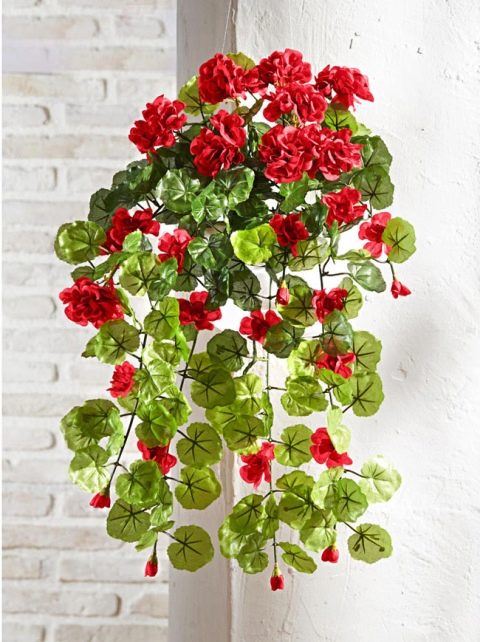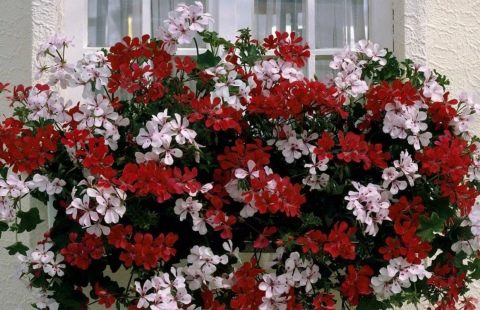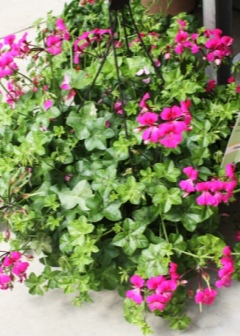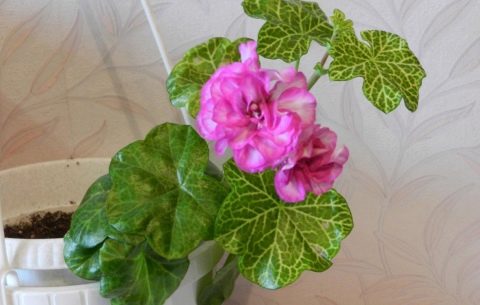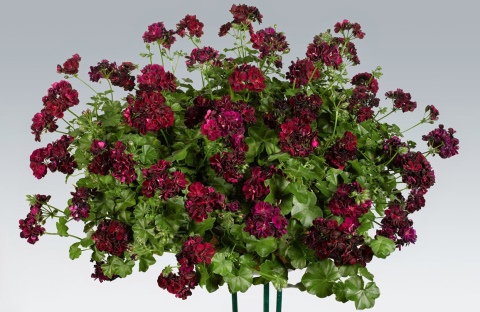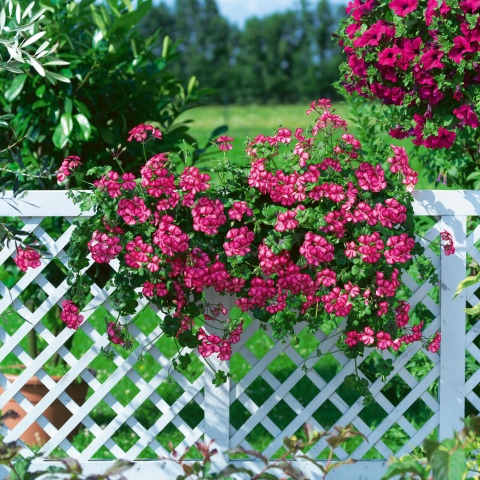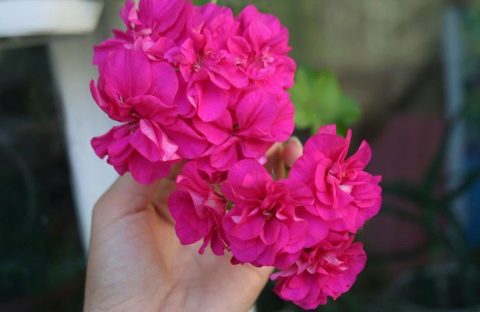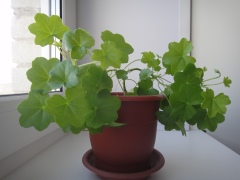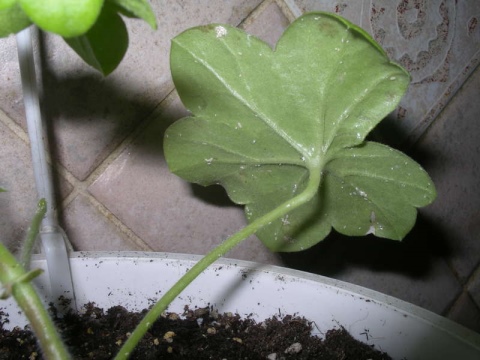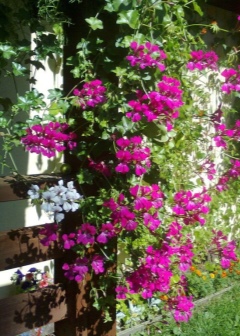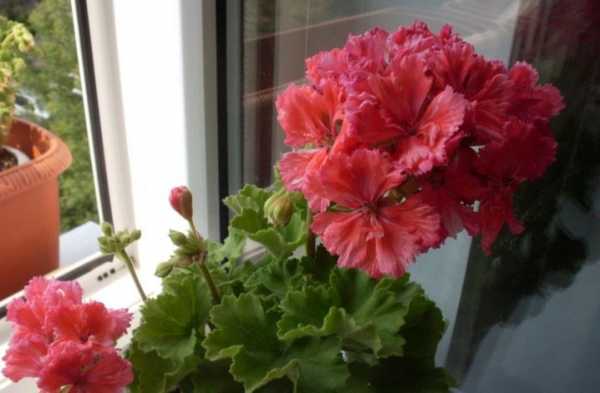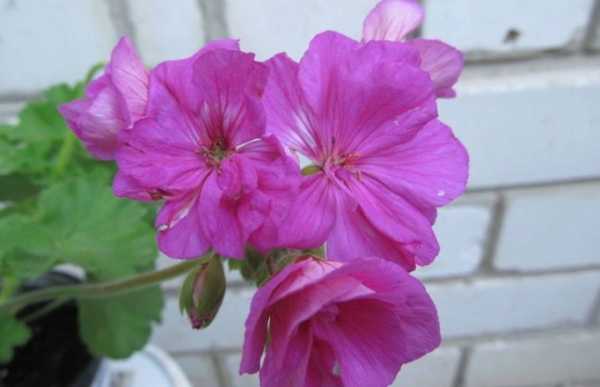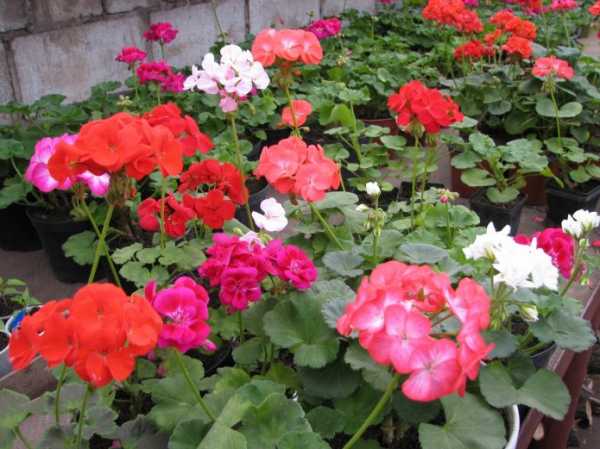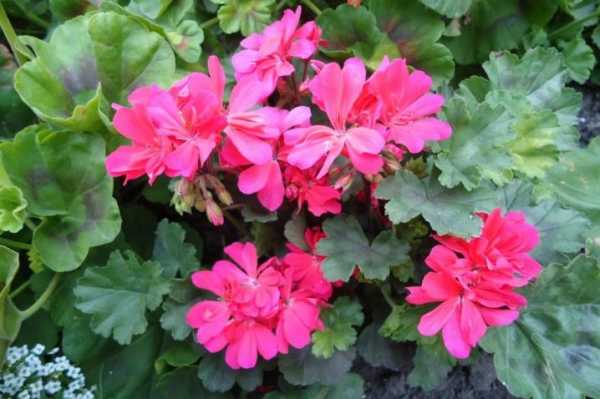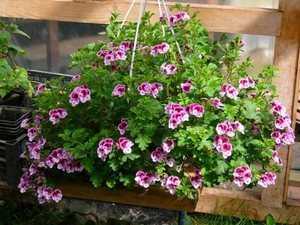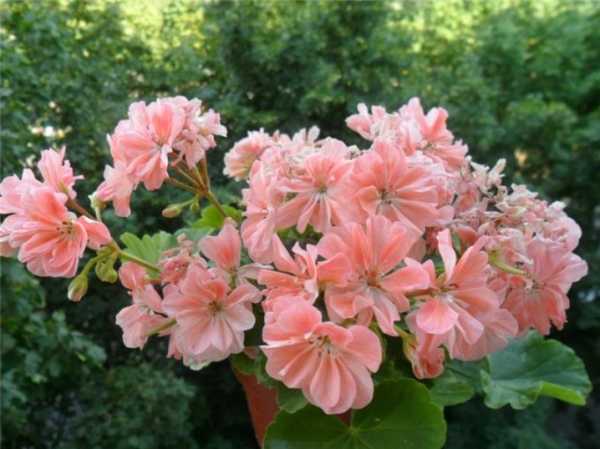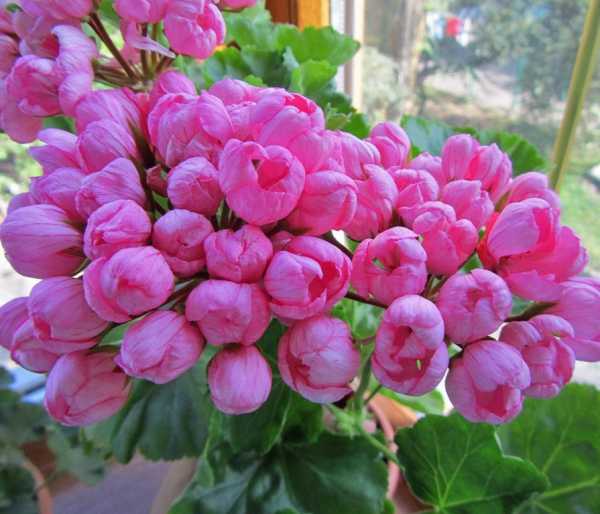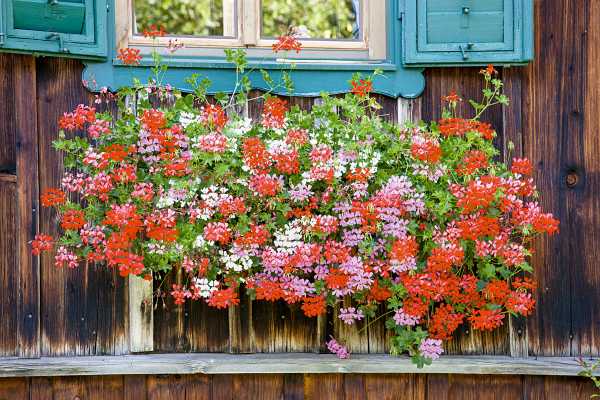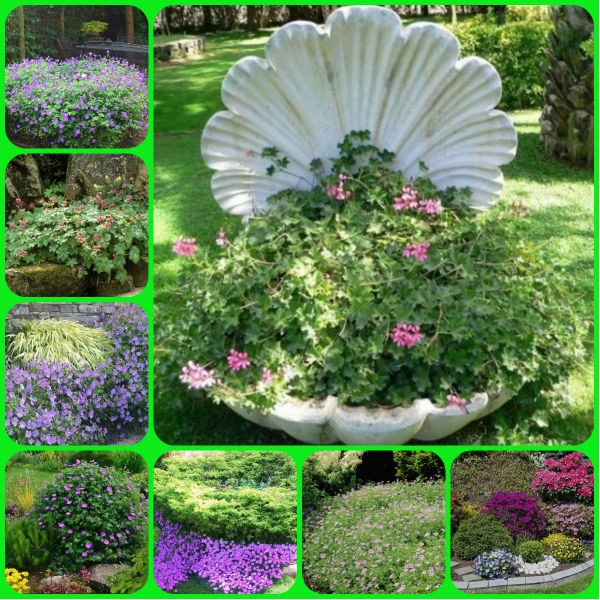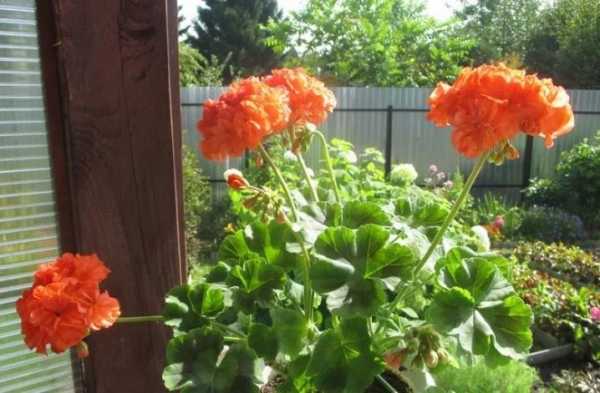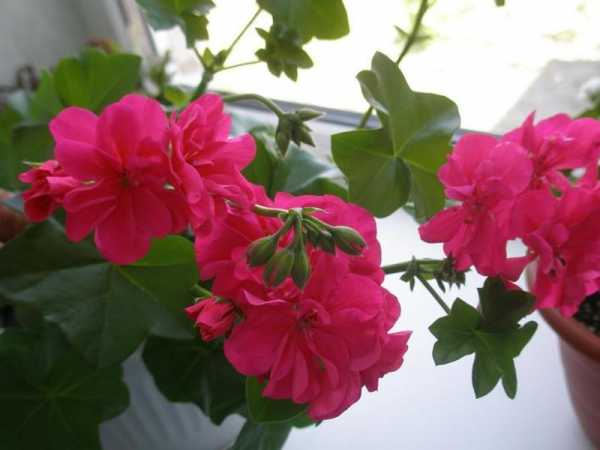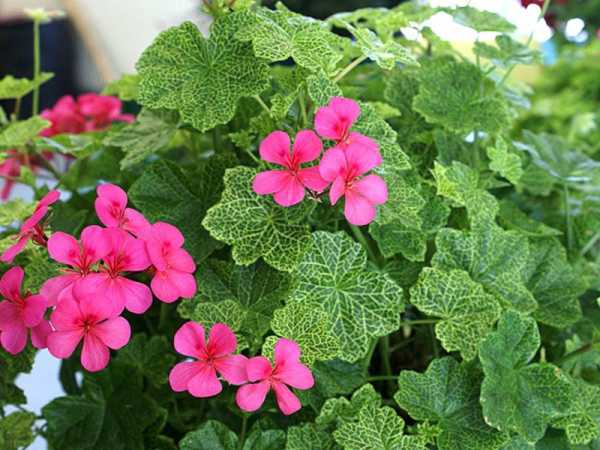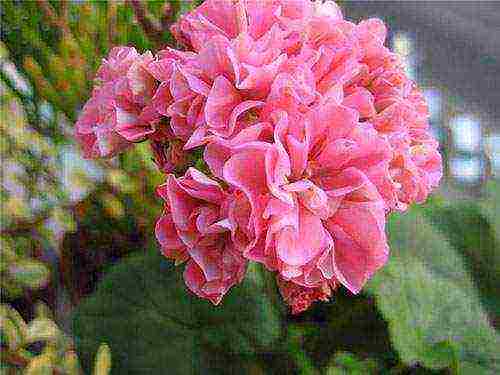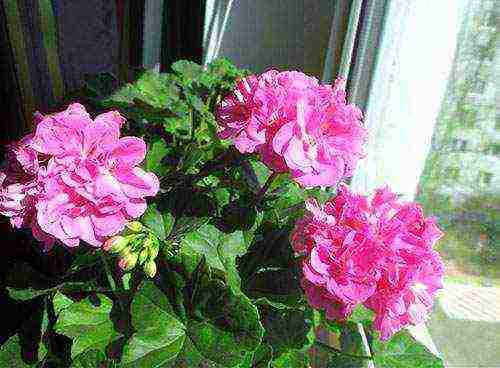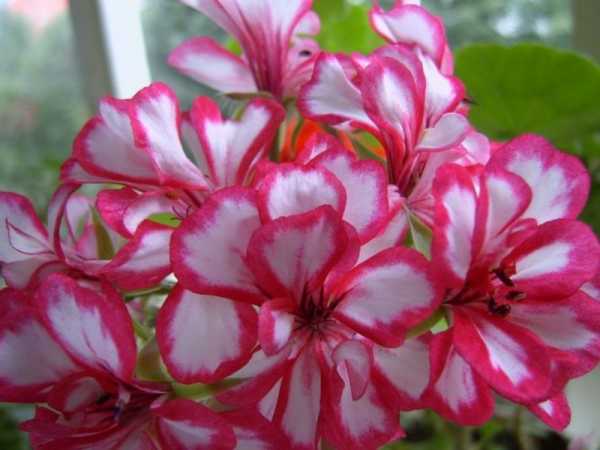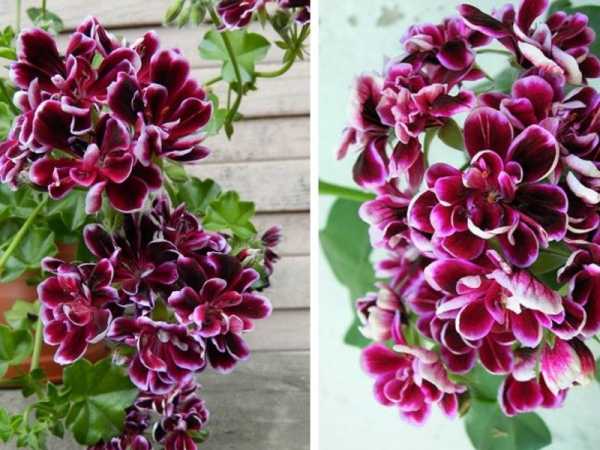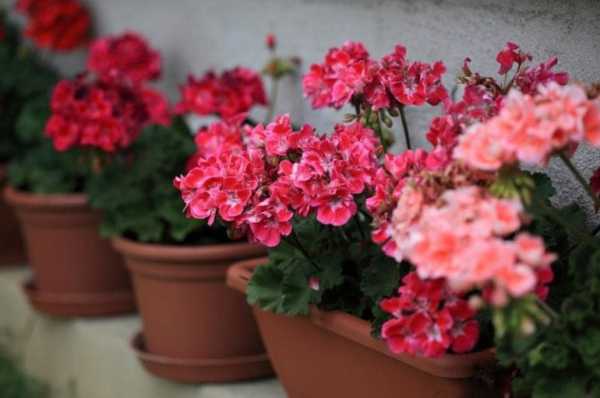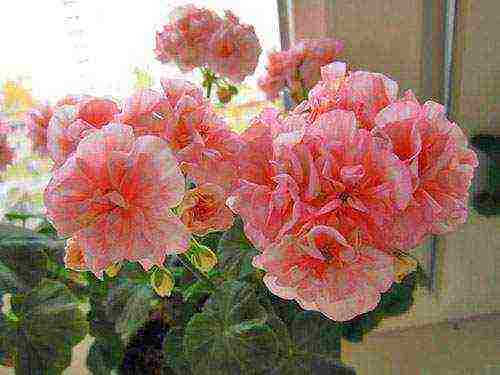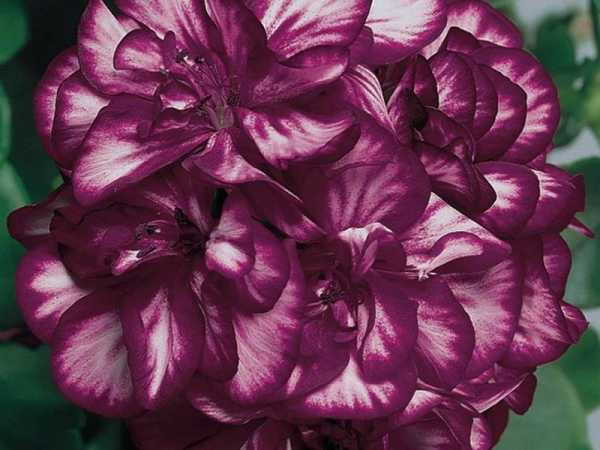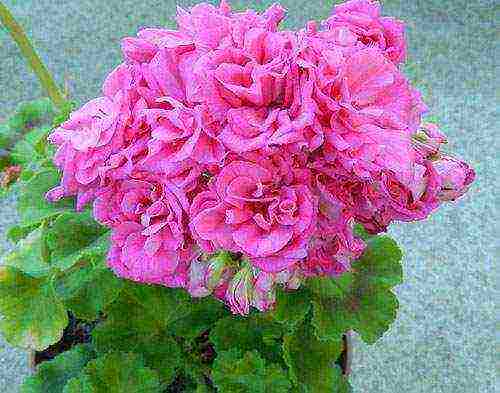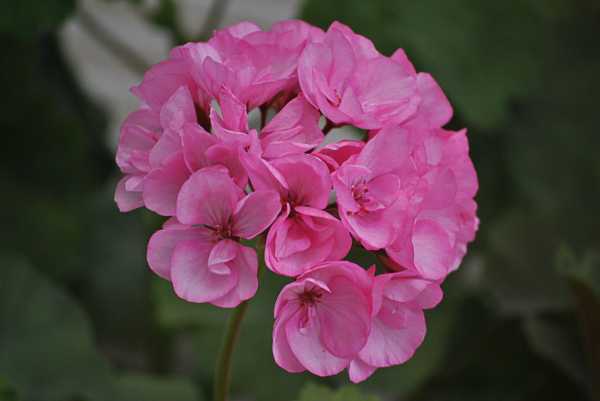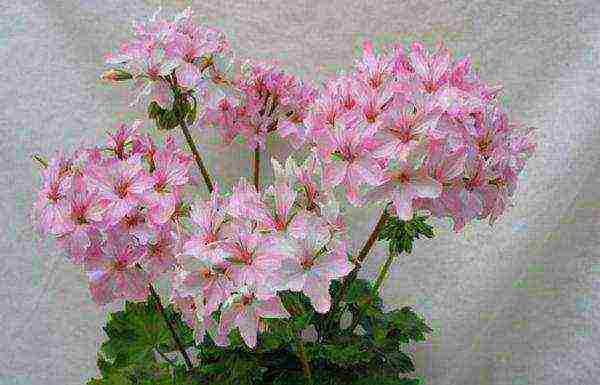Pelargonium ivy: the best varieties
Over the years of plant cultivation, flower growers have bred many varieties. Perhaps, every editorial office of gardening magazines has its favorites, but there are also recognized leaders. Also, if you wish, you can choose a mix in which a variety of shades of petals will be presented.
Great balls of fire burgundy
This variety is distinguished by its petals of a surprisingly white-burgundy color. This variety blooms from late spring to late autumn. You can also grow it indoors. Shoots grow by about 40 cm per year. This variety is very fond of the sun.

Pelargonium ivy Great Balls of Fire Burgundy
Bernardo
It is a terry variety with beautiful pink-red flowers. The reverse side of the petals has a lighter shade, often almost white.
Toscana Boneta
There are various color options, but the flowers will be large anyway, and the shoots are long. The most beautiful option is with white flowers that form a spectacular cascade.
Pac vicky
These are large flowers of a coral shade, the petals are much shorter in the center than at the edges. In general, the plant is as unpretentious as other varieties.
Great balls of fire melon
A very beautiful plant variety. Its flowers are distinguished by a deep crimson-red shade, the inflorescences are dense and large. The variety blooms for a long time. It can be grown both in pots and in balcony boxes.

Pelargonium ivy Great Balls of Fire Melon
In general, if the grower is interested in ivy-leaved pelargonium, easy care and abundant flowering are the main arguments in favor of the plant. It will decorate the east and west sides of the terrace. This variety is also used for aromatherapy. No wonder its flowers contain essential oil, the active ingredient of which - geraniol - is used in the perfumery industry.
Wintering conditions for street ampel pelargonium
In order for street pelargonium not to turn into an annual, you need to know about the conditions of its storage during wintering. The tropical beauty does not tolerate a drop in temperature below 10 degrees. In regions with cold winters and even in the European part, perennials quickly freeze and die even from short-term exposure to subzero temperatures. Also, do not transfer to the winter and grow those geraniums that are outdoor in ordinary home conditions. In this case, the plant will experience severe stress and may get sick.
For the wintering of ivy ampelous pelargonium, choose a cool room with good lighting. Even at this time of year, geraniums love bright lights. The air temperature in the room should be in the range of 10-12 degrees Celsius. If you keep a perennial in a pot, then occasionally water the soil so that it does not completely dry out and cause the death of the roots.
With this method of wintering a plant, a threat may arise that is directly related to various rodents. Mice can get to plants and eat not only the shoots, but also spoil the rhizomes. Protect perennials from rodents. If it is not possible to create the necessary wintering conditions for geraniums, then cut cuttings from the mother plants and propagate the perennial in this way, preserving all the characteristics of the mother bush.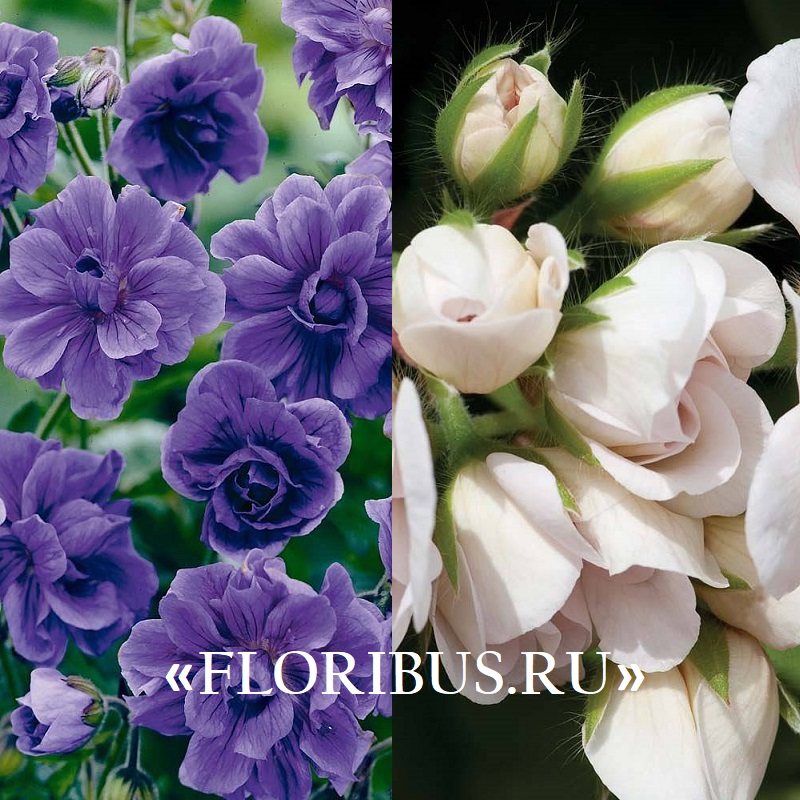
4. Varieties:
4.1.Pelargonium tulip
This variety was bred relatively recently. The first tulip pelargonium was patented in 1966. The plant is tall - reaches a height of 70 - 80 cm, has carved, rounded, green leaves with diverging veins and slight pubescence on long petioles. A distinctive feature is the presence of small inflorescences - umbrellas that bear half-open flowers in the form of a tulip bud. Shades of colors include white, red, lilac, pink, salmon and subtle purple.
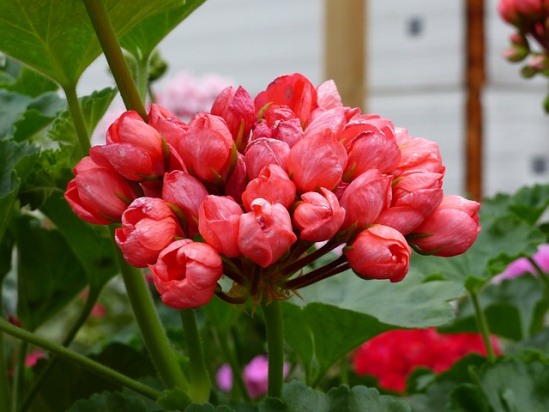
4.2 Variegated Pelargonium
Modern variegated varieties of geraniums include plants that differ not only in a variety of leaf colors, but also have leaves of different shapes.Among the shades of the leaves, there are green, grayish, burgundy, cream, white, yellow. Round leaves on long, slightly pubescent petioles have solid or ragged, carved edges. During the flowering period, the plant throws out thin, erect, tall, leafless peduncles, bearing inflorescences at the top - umbrellas with rather attractive simple, pink, red or orange flowers.
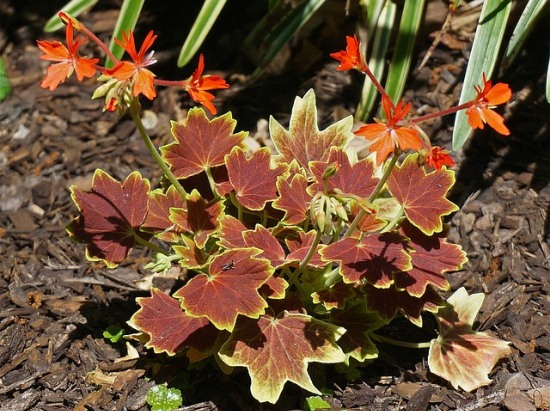
You may also be interested in:
Planting blood-red geraniums in open ground
To obtain long-term flowering, much depends on the choice of the site for planting geraniums in the open field and the creation of conditions for growth.

Vision pink grade
Location selection
For geraniums, it is recommended to choose a place with a lot of sunny color. The flower tolerates the shade painfully. But do not plant it in the sun. Direct sunlight for 4-6 hours a day in the summer will be enough for him.
How to prepare the soil and flower for planting
For planting geraniums, it is recommended to choose a light and nutrient-rich soil. In the open ground, they dig a hole two to two and a half times larger than a pot. With constant planting, the size of the pit is recommended to be 60 × 60 cm.

Flowerpot with blooming geraniums
Attention! Geranium does not like highly waterlogged areas. Cannot be planted in swampy and low-lying areas with high groundwater levels
How grandiflora reproduces
You can propagate royal pelargonium in different ways: by seeds, cuttings and air layers. Each of them has certain characteristics, so you should familiarize yourself with them.
Seeds
This method is the most laborious and time consuming, but it allows you to get a large number of new seedlings. At the same time, you can purchase planting material of the same variety and mixes.
Seeds should be sown in a moist soil mixture of turf, peat and sand in a ratio of 2: 1: 1 to a depth of 0.5 cm. After that, the container should be placed in a bright place with a temperature of +22 .. + 26 degrees. The first shoots appear after 2 weeks.
Cuttings
The vegetative method is considered the easiest. It should be used in spring and summer.
For propagation, it is necessary to cut the apical cuttings with 3-5 leaves. Then dry the lower cut for 2-3 hours, and only then powder it with a root former and plant it in the soil, consisting of turf of sand and peat in equal proportions.
For successful rooting, it is recommended to keep the soil constantly slightly moist and the temperature within the range of +22 .. + 25 degrees.
Note! Cuttings take root after 3-4 weeks

Cutting grandiflora allows you to get strong seedlings
Air layering
For reproduction of pelargonium in this way, it is necessary to measure the length of the cutting from the top of the shoot and make an oblique incision in depth by 1/3 of its width. Then powder the cut with any root former and put a piece of a match inside to prevent tissue fusion.
Then, a little below the cut, it is necessary to make a cuff from a film and put wet sphagnum moss inside. In such an environment, roots are formed after 2 weeks. After that, the layers must be cut 1.5 cm below the cuff and planted in the usual soil mixture.
How to care for pelargonium in summer
Experienced gardeners say about blood-red geranium, that if planting and care are carried out according to the rules, then in the first year it is able to give abundant growth and bloom. In the summer months, proper watering and feeding are important factors here.
Watering rules and humidity
Geranium cannot be called a moisture-loving plant, but this does not mean that you need to forget about watering. Watering is carried out evenly, with the obligatory loosening of the soil under the bush.
At high temperatures, watering is carried out 1 time in 4-5 days, under normal conditions, 1 watering in 7-10 days is enough.
Top dressing and soil quality
Top dressing is carried out with mineral and organic fertilizers.For the summer months, the use of complex mineral or aqueous solutions of organic fertilizers is recommended.
When grown at home, red geranium prefers slightly acidic or neutral soil. In open ground conditions, it is recommended to choose a neutral environment; garden soil is suitable here.
MAVERICK STAR grade
Pruning and replanting
In the summer, pruning is done only on wilted stems and inflorescences. It is recommended to transplant by dividing the bush every 3-4 years. Planting in summer in open ground has a positive effect on the condition of the plant. But then, in the fall, you will have to repeat the procedure in the reverse order.
Winter geranium care
Before the onset of winter cold, the shoots are cut off, so that 2-3 lower leaves remain. Bloody geranium is a frost-resistant plant, but many growers still recommend covering the bushes for the winter.
Attention! The description of many varieties recommends autumn pruning. The contraindication applies only to the royal geranium, pruning is very harmful to this variety
Therefore, you need to be very careful not to harm.
Caring for ampelous geraniums at home
Unlike zonal and royal pelargoniums, ivy-leaved plants have some features, mainly due to the growing conditions in their historical homeland - in southern Africa.
Illumination and temperature conditions
Without exception, all pelargoniums love sunlight. The best windows in the house for them are southern and eastern. However, since the seedlings are grown indoors, it is worth taking the pots out to fresh air gradually, giving them time to harden.
The optimum temperature for growth and flowering is + 18-22 ° C, but even at much higher temperatures, the bushes will grow well with regular watering. Ivy-leaved varieties can withstand a short-term decrease to 0 ° C without any special losses, but they freeze at negative temperatures.
Watering rules and humidity
Watering a cascading plant is necessary only when the soil in the pot dries out to half its height. If you fill in the roots, then they will definitely rot. Ivy-leaved varieties are especially sensitive to waterlogging. Just like all other species, this one does not need spraying even on the hottest days.
Top dressing and soil quality
The soil for planting must be chosen loose and fertile with a neutral alkaline reaction. Geraniums like to have a small amount of clay in the substrate. For looseness, add a third of the sand mixed with vermiculite.
Top dressing with complex mineral fertilizer for indoor flowering plants (for example, Agricola) is necessary during the period of active forcing of buds. It can be given with each watering, diluting in water in a concentration reduced by 4 times. But it is better to feed it every 2 weeks.
Important! In winter, only rare watering is left
Flower container size
Young seedlings are planted in starter pots with a capacity of 0.5 liters. As the root mass grows, the volume increases, but without sudden jerks. Usually, the next pot is chosen 2-3 cm larger in diameter than the previous one. If you give the roots too much freedom, this will negatively affect flowering, the shoots will become reluctant to trail.
Ampel geranium - care and cultivation, pinching, pruning
Shortening shoots should be handled very carefully. In young seedlings, shoots are not shortened, allowing them to gain length and form as many buds as possible.
Important! Pinching ivy pelargonium seedlings can lead to its death. The first pruning is done in the fall.
They shorten the lashes, which had time to become naked and even dry out. Re-pruning is done in the spring, shortening the shoots that have stretched out over the winter, giving the crown a neat shape. In summer, the bushes are not touched, allowing them to grow freely
The first pruning is done in the fall. They shorten the lashes, which had time to become naked and even dry out.Re-pruning is done in the spring, shortening the shoots that have stretched out over the winter, giving the crown a neat shape. In summer, the bushes are not touched, allowing them to grow freely.
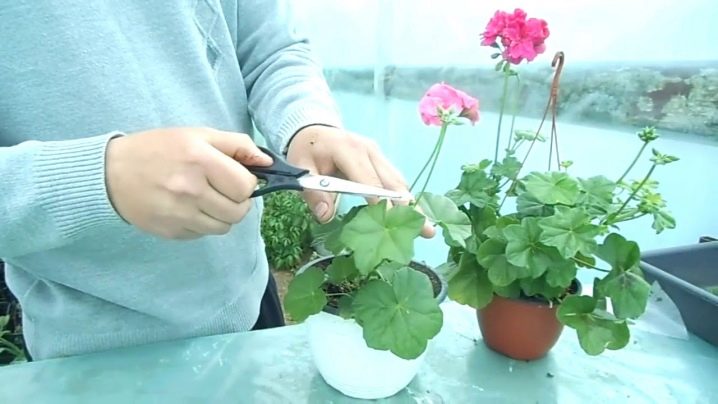
Pruning geranium
Growing and caring at home
- Watering. Like any plant, ampelous pelargonium needs moisture. But there shouldn't be too much of it. Watering should be systematic and moderate, the frequency of watering - as the topsoil dries out (2 times a week). In winter, during the dormant period, watering is done occasionally (once every 2 weeks).
The flower does not tolerate spraying! Such a procedure can provoke the appearance of a number of diseases in the plant.
- Temperature. For the full growth of pelargonium, a sufficiently high temperature is required - + 20C - + 25C. In winter, during the dormant period of the plant, the thermometer in the room where the flower will be stored should not show a mark above + 10C - + 12C.
- Top dressing. In the spring and summer, the plant needs nutrition. It will be appropriate to apply fertilizers containing a large percentage of nitrogen at the beginning of the season to build up the green mass of pelargonium, and during the flowering period, the fertilizers applied should be rich in potassium and phosphorus. The frequency of dressing is 1 time per 10 days.
- Pruning. In the fall, the ampelous pelargonium bush needs pruning, not only for aesthetic reasons, but also in order for the plant to remain healthy. Pruning should be deep: only those shoots that have come out of the root or have no more than 7 leaves are not touched. Dried lashes are removed, as well as those shoots that have come out of the leaf sinuses.
- Wintering. From late autumn to early spring, ampelous pelargonium enters a dormant period. She needs a fairly low temperature (+ 10C - + 12C), rare watering and the absence of any manipulations with it. It is better if the plant is taken to a utility room that corresponds to the recommended temperature regime, or a glazed but unheated balcony. In the case of wintering the plant in indoor conditions, flowering may not occur.
How to plant an ampelous geranium in a flowerpot
A very popular option for garden containers for planting plants is the pots. Geraniums can also be planted in this kind of device. The cache-pot is made from a special cement mortar using a special technology.
Important! Constant cultivation of a flower in such a container is undesirable. You can plant a plant in a pots for a while, but not more
Step-by-step algorithm for planting geraniums in pots:
- The bottom must have drainage holes. The plant does not really like moisture, therefore, when watering, the remaining water must self-destruct, otherwise the root will rot and the plant will die.
- A drainage layer of small pebbles is laid out at the bottom of the planter.
- Pour soil into the container, which is fairly enriched with peat and treated with agents from parasites and insects.
- You can plant a stalk or a fully formed bush.
- During the rooting period and the rest of the time, you just need to spray the soil. Watering is optional.

Geranium in pots
Note! To prevent the plant from disappearing, it is advisable to put the planter in the sun. The cement base of an unusual flowerpot can remain damp for a long time, so the sun should warm the ground well, evaporate excess moisture
To make the windowsill blooming and "alive", you should choose geranium as a houseplant. It is she who will be a good option if you want constant flowering, but there is no time to take care of the flowerpots. Geraniums are easy to breed and root well under the right conditions.
Fragrant geranium - what is it
According to the botanical classification, geranium (lat. Geranium) is a herbaceous perennial plant that prefers dry soils, sometimes winter hardy. Leaves are palmate or palmate, on long petioles, always with pubescence.

Fragrant geranium
The color of flowers, consisting of five petals rounded at the ends, is white, pink, purple, blue.Branched bushes with upward or creeping shoots.

Geranium leaf
Fragrant Pelargonium (lat. Pelargonium odorata) is an independent representative of the Geranium family with a chromosome set that differs from the classical geranium. These plants form bushes from erect shoots or drooping (ampelous). The leaves are pubescent (zonal varieties), as well as smooth, fleshy and shiny (ivy-leaved varieties).
Flowers are of all kinds - five-petal, semi-double, double, reminiscent of roses (rosebund). The color of the petals is almost any, one-color, two-color, multi-color, but never blue or purple.
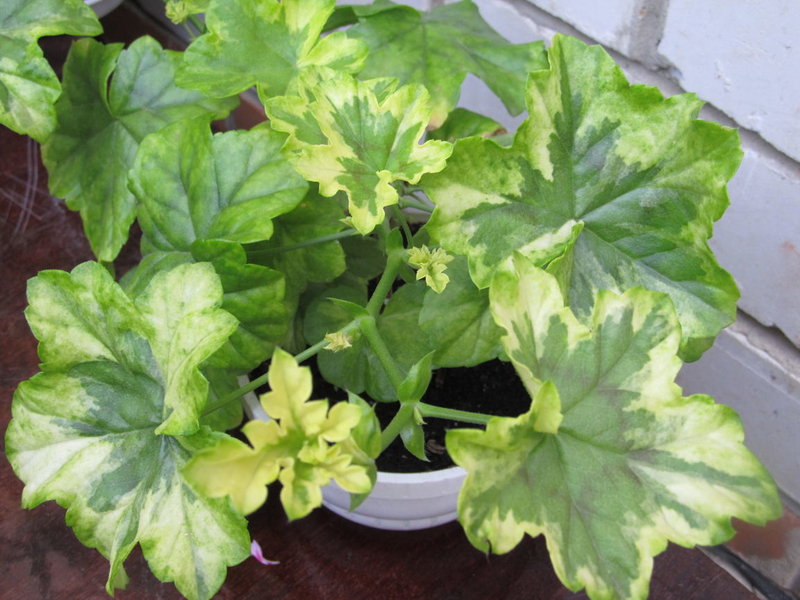
Leaves of ivy variegated pelargonium (variety Edinburgh)
Description and characteristics of appearance
Fragrant geranium is a trade name. On the price tags you can see the words: colon, perfume, fragrant. Plants of this group may actually belong to pelargoniums or geraniums, but they are always distinguished by inexpressive flowering and a bright, memorable aroma that leaves the foliage, it is enough just to touch it.
Fragrant geraniums look differently. Their foliage can be monochromatic - light or dark green, with a characteristic spot in the middle of a rounded leaf plate (zonal pelargoniums), but the most spectacular varieties with openwork pinnate foliage and variegated, combining several shades at once (yellow, green, pink, purple, etc.) etc.).

Fragrant pelargonium variety Lady Plymouth
History of origin or selection
There are a great many varieties of geraniums (over 400 species). They are found in nature almost all over the world.
For example, in Greece, the species Pelargonium graveolens (geranium graveolens) grows, which served as the ancestor of the varieties:
- Gray Lady Plymouth,
- Cinnamon Rose,
- Graveolens and others.
The curled-leaved variety is known as Pelargonium graveolens cv "Bontrosai" (toss).
All this serves as a vast genetic material for breeders who regularly present the latest developments.
For reference! Modern fragrant varieties are distinguished by their unpretentiousness, compactness of the crown, pleasant aromas and a useful ability to heal the air in the house, scare off flies and mosquitoes.
A non-capricious culture is suitable for novice growers, but in addition to benefits, there are contraindications for allergy sufferers.

